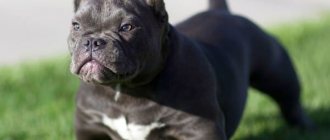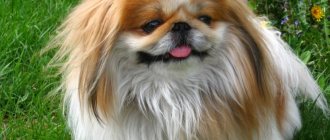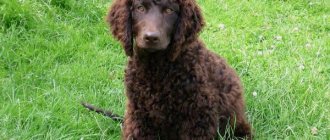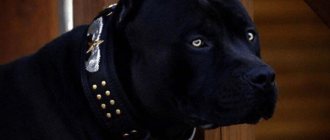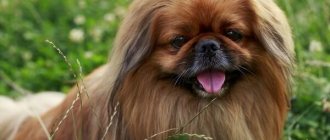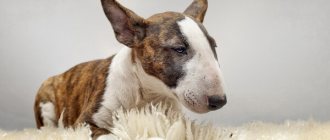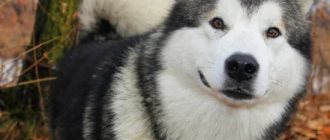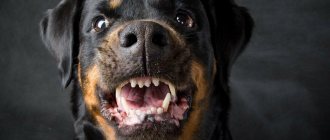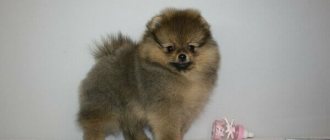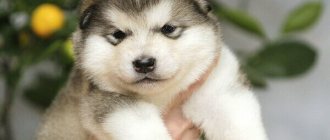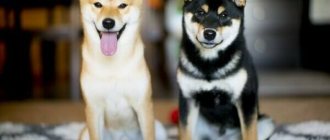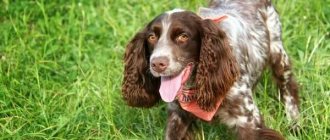Pit bull terriers, which have become almost synonymous with anger and aggression, are gaining more and more popularity.
Despite the mixed attitude of society, these dogs are characterized more as loyal friends and faithful companions than as ferocious and unbalanced dogs.
Those who love pit bulls, but cannot have such a pet because they live in a small apartment, should pay attention to their smaller copy - the mini pit bull.
Description of the breed and what it looks like in the photo
Mini pit bulls are dogs with a strong, stocky build, which makes them look bulky and powerful.
This build makes them unable to develop great speed, but in battle they compensate for this with the death grip of their powerful jaw..
- The body is rectangular, muscular, the back is straight and short with a smooth transition into a short loin. The chest is wide and voluminous, the ribs are rounded and arched.
- The belly is tucked in and connected to the chest by an almost straight line. The neck is short and thick, tapering towards the head, and the scruff is clearly defined.
- The head is wide and large, in the shape of a blunt wedge, proportional to the body. The skull is flat on top and rounded on the sides.
- Cheekbones and cheeks are emphasized and slightly saggy. If the animal grins or frowns, many skin folds form on the head. The size of the muzzle, slightly tapering towards the nose, is approximately equal to the skull, the lobe is black or colored to match the coat.
- The eyes are small, almond-shaped or round, set deep. The ears are set high and close to each other, erect at a natural length with the tips hanging down, but can be cropped.
- The limbs are short and powerful. The front ones are straight and strong, the shoulder blades are laid back and connect to the shoulders at a right angle, the rear ones are straight, set parallel and wide.
- The tail is short, set low, saber-shaped, not curled, not docked.
- The coat of dwarf pit bulls is short, thick and shiny, without signs of wavy, and lies tightly to the body.
Aggressiveness
Oh, the aggressiveness of pit bulls is legendary. However, for the most part they are very overblown, and in general the dog is less aggressive than many other breeds. What's the matter and did all the stories really start from scratch? This is an important issue that needs to be addressed in detail.
It's worth starting with your relationship with dogs. Yes, a pit bull never just rushes at anyone - only on the orders of the owner or in case it needs to defend itself. And then he immediately goes into a fighting frenzy, and it can be difficult to stop him. Considering that a pit bull's bite force is 1400-1500 Newtons, it is not difficult to imagine how the collision will end.
In addition, some pit bulls are purposefully trained to attack any target the owner points at. Unfortunately, the service is in demand and owners do not always give a deliberate order, carefully weighing the consequences. So it’s not the dog’s fault here, but the short-sighted owner.
Finally, dogs become aggressive if they spend a lot of time on a chain or in a very confined area. After all, a pit bull is an athlete by nature. He needs to run a lot to burn off excess energy. Otherwise, unspent strength accumulates and over time turns into aggressiveness. Who will it fall on? Most likely for the purpose specified by the owner. But maybe on the owner himself. So, here too the short-sighted person is to blame, who decided to get a strong dog without knowing its characteristics.
Origin story. Marriage or breed?
Pit bull terriers are one of the most popular dog breeds in the United States, which have become the unofficial symbol of this country . Moreover, a country where at the beginning of the 19th century. The ancestors of these dogs were bred - Staffordshire Terriers - in Great Britain.
It was there that dog fighting flourished, creating a need for fierce and fearless dogs, stubbornly pursuing victory. After the ban on such bloody entertainment, representatives of this breed began to be used as simple guard dogs.
After some pit bull terriers arrived in the United States with immigrants, American breeders and breeders began improving the breed, paying maximum attention to the psyche of its representatives, trying to make them softer and kinder.
The next, even more daring, step of the breeders was the creation of a variety of pit bull terriers, distinguished not only by their gentle disposition, but also by their more compact size..
Painstaking work on crossing pit bulls with Patterdale terriers was crowned with success in 1990 - it was then that mini pit bulls were bred, which became lighter and shorter in stature, but retained strength, endurance and energy.
These dogs have not received official recognition from the FCI..
John Colby's contribution to the development of the breed
It is worth noting that the greatest contribution to the development of this breed was made by John Colby, a resident of Ireland. He was a breeder of American pit bulls of the old family, but at the same time he believed that they should become the main link in breeding work with other lines. However, this opinion is still subject to criticism. Many modern breeders completely disagree with this policy. They believe that it was necessary to breed only the Red Nose line of American Pitbull dogs.
However, Colby's policy was correct. In 1900, he brought to America several of the best representatives of the named breed. And later he raised many legendary dog fighting participants.
In those days, it was quite difficult to create a reliable description of the American pit bull breed. The reason for this was the impossibility of controlling the number of dogs brought into the country, as well as the variety of their colors. In addition, the main thing was not the appearance of the animal, but its predisposition to participate in battles. However, there are documents confirming the development of the breed after 1900.
It is worth noting that the policy introduced by Colby was quite actively used by breeders who began actively breeding American pit bulls. By the way, this is why the term “American” appeared in the name of the breed.
Character traits
Mini pit bulls can be described as good-natured, playful, loyal to their owner, but at the same time stubborn, wayward and strong-willed dogs.
They are strong and fearless and would make excellent watchdogs, but they are too friendly towards everyone, seeing strangers only as potential friends..
Moreover, if the owner or one of the family members is in danger, the mini pit bull will selflessly protect them, even if the enemy is much larger and larger than him.
Breeders have made a lot of efforts to get rid of the aggression towards other animals inherent in representatives of this breed, and they partially succeeded - these dogs get along with other pets easier than standard pit bulls, but they are still treated aggressively towards strangers.
Unlike standard pit bulls, the miniature variety, although highly active, is still calmer and more patient and more similar to other companion dogs..
Expert opinion
Kozhevin Semyon Kirillovich
Expert dog handler.
Miniature pit bulls are intelligent, trainable, and always eager to please their owner. They value care and need it, love communication and attention. Training is significantly complicated by their stubbornness and willfulness, therefore it is important to show persistence and show that the owner is an unconditional leader who must be respected and obeyed. Socialization is extremely important for these dogs; without it, they can grow up aggressive.
Historical reference
Back in the 19th century, dog lovers in England, Ireland and Scotland began experimenting with crossbreeding bulldogs and terriers, looking for a dog that would combine the agility of a terrier with the strength and athleticism of a bulldog. The result was a dog that embodied all the virtues attributed to great warriors: strength, indomitable courage and gentleness with loved ones.
Immigrants brought them to the United States. The talents of the American Pit Bull Terrier did not go unnoticed by farmers and ranchers, who used their Pit Bulls to round semi-feral cattle and hogs, for hunting, to run livestock, and as family companions.
Pit bull terrier (from the English pit - fighting pit) means fighting bull terrier. Initially it was called “pitdog” (fighting dog), “half and half” (50 to 50), “bullend terrier” (bulldog and terrier), “American bull terrier”, “Yankee terrier”.
Over time, the final name was formed, which became the official one - “pit bull terrier”, which was popularly shortened to “pit bull”, which is considered an incorrect name, since translated it means “fighting bull”.
The breed was recognized in 1898 by the British Kennel Club (UKC), and in 1930 by the American Kennel Club (AKC), however, it did not receive international recognition at the FCI level.
Advantages and disadvantages
Advantages of mini pit bull terriers:
- friendliness;
- mind;
- ability to learn;
- courage;
- devotion;
- love for children;
- moderate shedding.
The disadvantages of the breed include:
- stubbornness;
- aggression towards other animals;
- the need for competent education and socialization.
In addition, these dogs are not suitable for street keeping or use as guard dogs.
Physical exercise
Before getting such a dog, make sure that you have enough time and opportunity to provide your pet with the optimal amount of daily training, think through stimulating games and activities.
Your daily ritual should be a walk in the park, regular running and jogging.
If you plan to keep the dog in an apartment as a house friend, then a mini pita is not exactly what you need, because this breed requires constant, daily work and sports training.
If you don't follow this rule, your pet can become disappointing: due to the excess of unspent energy, the dog's behavior can become a real nightmare.
The pet will damage furniture and interior items, constantly bark, and show aggression towards people and other animals.
If you don’t have enough time to walk your dog in the fresh air, it needs to be exercised at least on a treadmill.
Color variations
The coat of this breed can come in a variety of colors, be a solid color, or have lighter and white markings on the paws, neck and chest.
The most common and popular colors black , white and gray .
Popular colors of American Pit Bull Terriers
The coat of pit bulls is quite close-fitting, short and harsh, and they have no undercoat at all. If we talk about the color of these dogs, there is a huge variety here, allowing for any colors, tones, white and dark spots. The exception is such a color as merle (marbled), it is considered unacceptable, such dogs are rejected.
There is a conditional division of pit bull colors into three varieties; dogs are divided into:
- Spotted;
- Solid;
- Tigers.
As for the last (tiger) color, it is not uncommon; this color is called natural. The stripes can run all over the dog’s body, they can be only in the area of the spots or, conversely, everywhere except the spots. Black coloring is often confused with blue if the color is not very intense. Many people consider such dogs to be more aggressive, but this is not so, these pit bulls are only more frightening in appearance, but they are the most loyal and loving four-legged animals. In the States, this color of dog coat is very popular.
Blue or blue pit bulls are not often seen, they are rare and are in great demand in terms of acquisition. Due to high demand, inexperienced clients are often given black dogs, passing them off as blue. White pit bulls are also found, they are completely monochromatic, with the exception of the muzzle. There are some differences in the shades of this color (lighter and closer to gray colors). White is allowed in the form of spots against the background of another color or as a third color.
Chocolate colors of pit bulls are quite popular, the following colors stand out among them:
- Chocolate;
- Cocoa (light chocolate);
- Dark chocolate;
- Chocolate and tan;
- Chocolate white.
Gray colors are characteristic of pit bulls, otherwise they are called fawn. They have the color of white sand. They are often compared to the red and tan colors characteristic of this breed.
The location of these colors relative to color intensity looks like this (in order of magnitude):
- Fawn;
- Redhead;
- Red.
In general, we can say with confidence that the colors of American pit bull terriers are presented in a wide range of colors, so to speak, for every taste; stripes, white spots, and even three-color coats are allowed.
Diet
The diet of mini pit bulls can be based on natural products or industrial food - the choice depends on the dog owner. Both types of nutrition have pros and cons, so it is impossible to say unequivocally which one is better.
Thus, high-quality industrial feed, belonging to the premium, super-premium or holistic class, has a balanced composition enriched with vitamins and minerals, they are easy to use and dose, and can be stored for a long time.
At the same time, in case of an allergy to some component of the feed, a complete change of diet will be necessary.
NOTE!
Representatives of this breed are more suitable for food brands Eukanuba, Probalance, Pro Pac, Hill's, Royal Canin, Go.
Natural food requires more time to prepare food, but allows the owner to independently choose food for the pet and is safer when considering the risk of an allergic reaction.
The natural diet should include:
- offal;
- lean meat;
- veins and cartilage;
- sea fish;
- dairy products;
- vegetables;
- porridge.
It is forbidden to feed mini pit bulls:
- pickles, marinades;
- spicy and fried foods;
- sweets;
- milk;
- bakery and pasta products;
- potatoes.
With this type of nutrition, it is necessary to give the dog a vitamin and mineral complex.
Feeding
Pit bulls are recommended to be fed a diet of 2 to 2.5 bowls of quality dry food per day, divided into two meals. However, the right amount of food for your dog depends on many factors, including age, metabolism, build and activity level.
To prevent obesity, measure the amount of food your dog eats and feed him at a set time each day. A Pitbull should have a defined waist when you look down at it, and you should feel its ribs underneath the layer of muscle, but not see them. If the ribs are under a noticeable layer of fat, then he needs a diet.
Health and major diseases, life expectancy
The rather heavy build of miniature pit bull terriers causes them to often have problems with the heart and breathing; representatives of this breed often experience shortness of breath, so they have difficulty withstanding hot weather.
In addition, these dogs are susceptible to a number of hereditary pathologies, among which the most often diagnosed:
- heart disease;
- hypothyroidism;
- aortic stenosis;
- hip dysplasia;
- allergic reactions to food, certain medications, and external irritants such as pollen or insect bites.
Experts also say that mini pit bulls are susceptible to helminthiasis, so you need to carefully monitor what your pet eats and not neglect the timely use of anthelmintic drugs.
At the first signs of illness and symptoms of pathology, it is necessary to show the dog to a veterinarian.
The average lifespan of these dogs is 11-13 years.
comments
Bullypit Half of the photos in the article are amtsaffs and bullies, not pitas. The author says that poods have never seen Pete live
- Adam Well, so what, staffs or pit bulls are the same type of breed, essentially the same thing, even experts confuse staff or pit bull because... one breed. The staff breed became only in the 1970s, lovers of the Pitbull breed did not have standards and did not take dogs to exhibitions because of this, because the dog was a fighting dog and it didn’t matter height, weight, etc., then they established standards and then appeared Staff. I wrote this in a nutshell, but what’s more, I didn’t see a good article, I don’t see the truth here, just as others wrote here. (pit bull breeder 13 years old)
Luba Such nonsense has been written, a lot of lies. It’s immediately obvious that a person who has absolutely no knowledge of the breed wrote this article.
How are children treated?
Although miniature pit bull terriers choose one owner, they love all family members, and are especially kind to children..
These dogs have a high pain threshold, so they tolerate children’s less-than-cautious attitude, expressed in pulling their ears or tail, easily and are not irritated.
Representatives of this breed are inquisitive and active, so fun and active games with kids bring them pleasure . These dogs become not only friends and nannies for children, but also loyal protectors.
What is the price
Due to the fact that the American Pit Bull Terrier is not registered with the FCI, the breed is not considered an elite breed. And yet, in nurseries, the cost of puppies sometimes reaches a fabulous sum. Often it is a reflection of the owner’s ambitions, rather than the real qualities of the animal. Although pit bulls do not participate in competitions, they are still divided into 2 groups:
- Pet class. Pets intended for home keeping. They do not participate in competitions or breeding. Dogs of this class can participate in agility, but do not win prizes. The cost of such puppies is 7-10 thousand rubles.
- Brid and show class. Bright representatives of the breed with a typical exterior. The parents are titled; distant relatives may include American manufacturers. Puppies cost from 30 to 60 thousand rubles.
At this age, it is more difficult to retrain a dog; you will have to spend a lot of time so that it begins to consider you the owner. Although in other countries it is customary to buy a pit bull terrier at the age of 6-8 months, when the animal already knows all the commands.
It is better to buy a puppy from a nursery. Private breeders, especially those found through advertisements, can deceive the buyer. The kennel must have a good history, it must be clean, and all dogs must be properly cared for.
Features of care
Mini pit bulls are dogs intended for home keeping..
They cannot live outside because they are sensitive to frost and heat. At the same time, living in an apartment or house, representatives of this breed need daily active walks.
Wool and bathing
The coat should be brushed weekly with a soft-bristled massage brush. After walks, you need to wash your pet's paws, and you should bathe him completely no more than once every 2-3 months to avoid drying out the hairs.
When bathing, you need to use a shampoo that is suitable for your dog’s coat type and make sure that foam and water do not get into the dog’s ears..
Teeth
To avoid the formation of plaque and tartar, brush your dog’s teeth twice a week with a special brush and toothpaste.
Eyes
Every morning, wipe with a lint-free cloth soaked in boiled water or chamomile infusion, making sure there is no strong souring and increased tearing.
Claws
Trim as it grows, approximately once every 3-4 weeks, with a guillotine nail cutter so as not to touch the living part and blood vessels.
Ears
Wipe weekly with a soft cloth soaked in a special lotion to remove accumulated wax and dust.
Maintenance cost
Buying a pit bull is only half the battle. Next, this handsome guy needs to be maintained. Let's calculate how much it will cost to keep a dog for a month.
Nutrition
This is the most serious expense item and you cannot skimp on a dog here.
If you prefer to save your time and feed your pet dry food, then about 200-250 grams of dry food will be consumed per day. As mentioned above, the food must be of high quality, at least one third consisting of dehydrated meat and offal. The cost of premium food is about 400-600 rubles. That is, you will have to spend 2.5-5 thousand rubles a month on your pet’s diet.
Of course, if you are ready to cook porridge from natural meat and cereals several times a week, your costs will be reduced.
Veterinary
In general, pit bulls are in good health. But it is still necessary to undergo an examination by a veterinarian. A preventive visit costs approximately 500 rubles - adjustments are possible, depending on the locality and the clinic itself. It is advisable to take a young dog for examination annually, and an older dog every 6 months.
In addition, do not forget about seasonal vaccinations and parasite treatment.
Grooming
Mostly, owners themselves take care of their pet’s hygiene. But before the exhibition, it would be a good idea to pay a visit to the salon, where he will be washed with a special shampoo, thoroughly combed, his claws trimmed and other preparatory work done.
Exhibitions
Each club holding an exhibition sets the amount of the participation fee at its own discretion. Therefore, the amount ranges from a couple of hundred to several thousand rubles. Of course, the more prestigious the exhibition and the more expensive the prizes, the higher the cost of participation. However, here the owner himself decides to take the pet to the event or refuse. This will not affect the health of the pit bull or the relationship with the dog.
Training and education
During training, you cannot physically punish the dog or shout at it; commands must be pronounced calmly, but firmly and confidently, not allowing it to evade their execution.
It is better if the training takes place in a playful way and immediately after a walk, when the pet is tired enough and will no longer be distracted by external stimuli..
First you need to accustom the puppy to the nickname, calling him by name as often as possible. Afterwards, you should practice the “come to me” command, calling your pet when it is at a distance, but within sight.
Basic and necessary commands for mastering also include the commands “sit” (“lie down”), “no”, “wait” and “place”, and while walking you will need the command “near”.
To make care and maintenance easier, it’s a good idea to master the command “give me your paw” and develop your pet’s endurance.
IMPORTANT!
After each correctly executed command, the pet should be praised and treated with a treat - this helps to consolidate positive associations.
Hygiene
You don't need to bathe your pit bull puppy often. Exceptions are cases when he gets dirty in the mud or swims in a puddle. If the puppy is white, or just light-colored, it will be more noticeable when it's time for a bath.
When it comes to bath procedures, certain rules are followed:
- use puppy shampoo;
- water temperature not higher than 38°C;
- the puppy is rinsed with clean water to wash away any remaining soap, and then dried thoroughly with a dry towel;
- It is not recommended to dry wool with a hairdryer, but if there is such a need, use a weak blowing mode;
- after swimming they do not go outside for about 3 hours.
During and after bathing, make sure that the puppy is not exposed to a draft.
To maintain oral hygiene, you need to properly care for your teeth - for this you use a special paste and a brush, similar to a human one, or one that is put on your finger. The dog is gradually accustomed to this procedure, always starting with the far teeth on the outside.
The puppy's eyes should always be clean. If discharge appears, the eyes are washed or treated with special medications. If the discharge is permanent, consult a doctor.
Ears are cleaned every week. To do this, use a cotton swab and ear cleaner.
It is important to regularly check your dog for ticks - they like to “cling” closer to the ears, jaw and neck
How to choose?
Buying a puppy of this breed from a specialized nursery is not a whim, but a necessity . This is the only way to minimize the risk of acquiring a mixed breed or a sick animal.
In addition, breeders will provide all the necessary information about the parents of the future pet, talk about how to properly care for it and can guarantee that the puppy does not have genetic pathologies or developmental disorders.
You should not rush into choosing a dog and buy the first puppy you like . It is necessary to observe the behavior of children, to understand what character traits are inherent in them.
Thus, apathetic puppies that do not take part in the games of their littermates will most likely grow up calm and even lazy, but curious and active puppies will become energetic and playful dogs and will not lose these qualities even in adulthood.
It is also important to make sure your pet is healthy.
He should not have any rashes or irritations on the skin, a dull coat with traces of dandruff, a bloated belly, excess weight or exhaustion, discharge from the ears or nose, increased tearing or signs of sour eyes.
Pit bull color genetics: many nuances
The American Pit Bull Terrier has short hair with a hard, elastic, close-fitting outer layer of hair. There is no hair in the pit bull's belly area.
The muzzle, paws and ears are covered with “velor” fur, shorter than the guard hair. The pigmentation of a pit bull’s nose, lips, and irises varies, as does the color palette of the coat.
The dog's coat can be anything: the breed even allows random inclusions of white and colored spots.
Attention! People who want to buy an unusual-looking pit bull are not fully aware of the problems they may face in the future. There are colors (for example, merle) that are artificial for pit bulls and lead to congenital diseases and serious mental disorders.
Before purchasing a cute pit bull puppy, you should learn not only the history of the origin of the breed, its biometric characteristics, but also understand why, for example, buying a luxurious Albanian pit bull or a blue-eyed albino will entail many problems and difficulties.
Price range
Miniature Pit Bull Terriers are hybrid and quite rare dogs that were bred just a few decades ago.
The popularity of this breed and the growing demand for its representatives have led to the emergence of a mass of unscrupulous breeders, so you should buy a puppy only in specialized nurseries, of which there are very few in the CIS countries, or order from Europe or the USA.
The cost of a mini pit bull puppy is at least 15 thousand rubles. and increases depending on its class, and in the case of an order from another country, the cost of shipping the dog will be added to this price .
Photo gallery
Don't be fooled by the small size of these dogs - they are excellent guards and companions. For our readers, we have prepared a selection of photos of these rare dogs in the CIS.
